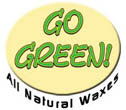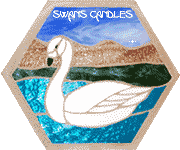
 MAKING SUPPLIES
MAKING SUPPLIESEncaustic is now undergoing another revival fur its use in easel painting. Its effects, its visual and physical properties, and its range of textural and color possibilities make it eminently suitable for use in several different contemporary styles of painting that are not adequately served by our traditional oil-painting processes.[2] During the twentieth century, the availability of` electrically heated equipment and commercially prepared materials has greatly facilitated the use of the ancient wax-based medium of encaustic. A major figure in its early revival was Karl Zerbe, Head of Painting at the School of the Museum of Fine Arts, Boston from 1937 to 1955. Soon thereafter, Jaspcr Johns revolutionized the possibilities of this ancient medium with his seminal collage paintings of 1954 and beyond. Brice Marden and Lynda Benglis created highly influential paintings during the 1960s and '70s that further extended the parameters of encaustic and wax-based media. As an unpredictable, organic medium, encaustic has especially been embraced by a generation of process-oriented artists reacting against the industrial, prefabricated mediums of Minimalist and Conceptual art. Today, at the end of the century, many artists find encaustic to be uniquely appropriate for the communication of a vast array of spiritual, philosophical, environmental, and painterly concerns. Functioning as a seductive skin or membrane, encaustic is an unusually malleable and mutable medium that evokes bodily sensations, emotions, alchemical transformations, religious rituals, layers of history, and the passage of time.
• 2.5 ounces olive oil (substitute grapeseed oil if you have oily skin) • 1/2 ounce pure beeswax • 12 drops grapefruit seed extract • 4 ounces distilled water Combine the oil and beeswax in a double boiler. (If you don't have a double boiler, place the oil and beeswax in a small pan set inside a larger pan containing boiling water, on the stove.) Once the wax is melted, remove from the heat, add water, and mix with a hand or electric mixer until creamy. Stir in the grapefruit seed extract, and place in a glass jar with a screw top. Makes: 1/4 cup Shelf Life: 1 year
4 oz. sweet almond oil 1 oz. beeswax 2 oz. water 10 drops Vitamin E oil 10 drops lavender essential oil Melt the oil and the wax in a double boiler, Remove from heat, add water, and stir thoroughly. Add your Vitamin E, essential oil and stir continuously until cool. This cream is very moisturizing and emollient. It is nice for rough, dry, or chapped complexions and should help promote healthy looking skin. After you have added the essential oil and the cream is still warm enough to pour, carefully pour it into Salve Jars or Metal Tins.
Ingredients: 2 ounces Beeswax 3 ounces Sweet Almond Oil 1 ounce Jojoba Oil 20 drops Wheat germ Oil 20 drops Myrrh Essential Oil 20 drops Tea Tree Essential Oil ( Makes enough to fill 4 each 1 ounce salve jars or 1 ounce metal tins ) A rule of thumb is 2 parts oil to one part beeswax. Simply heat the Sweet Almond and Jojoba oil in a saucepan and add Beeswax. If you want a thin consistency ( such as a cream or Vaseline ) add only a little bit of Beeswax. Want it thicker like wax? Just add more Beeswax. Allow the base to cool down to see what the consistency is like. If it's too thick, add more Sweet Almond oil and reheat, too thin?, add more Beeswax. As the base is cooling add the essential oils to enhance the healing effect of the balm. After you have added the essential oil and the lip balm is still warm enough to pour, carefully pour it into Salve Jars or Metal Tins.
Make different Herbal Salves simply by changing/mixing differnet essential oils! Ingredients: 2 ounces Beeswax 3 ounces Sweet Almond Oil 1 ounce Jojoba Oil 1/2 oz. Canola oil 40 drops total essential oil of your preference ( Makes enough to fill 4 each 1 ounce salve jars or 1 ounce metal tins ) Simply heat the Sweet Almond, Canola oil and Jojoba oil in a saucepan and add Beeswax. If you want a thin consistency ( such as a cream or Vaseline ) add only a little bit of Beeswax. Want it thicker like wax? Just add more Beeswax. Allow the base to cool down to see what the consistency is like. If it's too thick, add more Sweet Almond oil and reheat, too thin?, add more Beeswax. Itch Relief Salve ( Good for posion ivy, posion oak ) 1 pint Sweet Olive Oil 2 ounces Beeswax 1 tablespoon Chickweed Powder 1 tablespoon Comfrey Powder Put chickweed and comfrey powder into sweet olive oil and simmer 3 hours. Strain and add beeswax. Pour into salve jars or tins.
Ingredients: 2 tablespoons beeswax 2 teaspoons distilled water 4 oz. cocoa butter 4 tablespoons sweet almond 2 tablespoons coconut oil Melt the beeswax over low heat with the water. Spoon in cocoa butter and blend. Gradually blend in oils. Pour into glass jar. The lotion will thicken as it cools.
This makes a great vaseline type jelly without petroleum products. 1 ounce (weight) beeswax 1/2 cup baby oil Melt the beeswax in a microwave or a double boiler. Stir in the mineral oil. Remove the mixture from the heat and stir until cool.
2 1/2 ounces (weight) beeswax 4 ounces (weight) lanolin 2/3 cup baby or mineral oil 3/4 cup water 1 teaspoon borax (sodium borate, CP) Fragrant oil (optional) Melt the oil, lanolin and beeswax to 160 degrees F. Heat the borax and water in a separate container to 160 degrees F. Be sure the beeswax is melted and the borax is dissolved. Add the water mixture to the oil mixture while stirring. When a white cream forms, stir slowly until the mixture cools to 100 degrees F. Pour the cream into small, wide-mouth jars.
1 tablespoon Chickweed powder 1 tablespoon Wormwood Powder 10 drops Tea Tree oil 2 pints Sweet Olive Oil 3 ounces Beeswax Mix together chickweed, wormwood powder, add the mixed herbs to sweet olive oil and simmer 3 hours. Strain and add beeswax and Tea Tree Oil. Pour into salve containers.
2 ounces beeswax 1 cup sweet almond oil 1 cup water 10 drops essential oil (if desired, for fragrance) Heat beeswax and sweet almond oil until the wax melts. In another container, heat water until warm. Both mixtures should be warm, but not so hot as to be uncomfortable to the touch. Place warm water in a blender. Cover the blender, leaving open the small opening in the cover. With the blender running on high speed, slowly pour in the beeswax-oil mixture in a thin stream. When most of the oil has been added, the mixture should begin to thicken. At this point, add the essential oil. Continue to add oil and blend until the mixture is sufficiently thickened. Turn off the blender. You should have a thick cream. Spoon into salve jars or metal tins.
This is a great recipe that does not spoil easily without the aid of refrigeration. It makes about 2 cups of lotion. 1 cup of aloe vera gel 1 teaspoon of lanolin 1 teaspoon of pure vitamin E oil 1/3 cup of coconut oil 1/2 ounce of beeswax 3/4 cup of almond oil Up to 1 and 1/2 teaspoons of essential oil of your choice or more to prolong scent Place aloe vera gel, lanolin and vitamin E oil in a blender or food processor. Place coconut oil and beeswax in a 2 cup Pyrex measuring cup, microwave on high for 30 second and stir. Repeat in ten second blocks until fully melted. Stir in almond oil, reheating if necessary. Run blender at low to medium speed, then pour in melted oils in a thin stream. As the oils is blended in the cream will turn white and the blender's motor will begin to grind. As soon as you have a mayonaise-like consistency, stop motor, add essential oils and pulse blend. do not overblend Transfer cream to glass jars while still warm because it thickens quickly. This recipe was found in the Winter 97 issue of Handcraft Illustrated Magazine. The article was written by Amy Jenner
4 ounces sweet olive oil 3 to 4 ounces beeswax 1 ounce cocoa butter 15 drops vitamin e oil 25 drops lavender oil Combine the sweet olive oil, beeswax, cocoa butter and heat thoroughly in the top of a double boiler. Remove from the heat. Add the vitamin e, lavender oil and beat well. Pour into salve jars and allow the mixture to cool before covering.
Ingredients: 3 ounces beeswax 2 ounces cocoa butter 3 ounces sweet almond oil Melt and mix all ingredients thoroughly. Mold into desired shape.
by Rosemary Gladstar in Tasha Tudor's Heirloom Crafts Ingredients: 3/4 cup sweet almond oil 1/3 cup coconut oil or cocoa butter 1 Teaspoon lanolin 1/2 ounce grated beeswax Melt ingredients together over low heat and cool to room temperature. When cool, add: 2/3 cup rosewater 1/2 cup aloe vera gel 1 - 2 drops rose blend EO 5 drops Vitamin E oil Whip all ingredients to a smooth consistency. Store in a sterile covered jar.
Ingredients: 3 parts Sweet Almond or Jojoba oil 2 parts White beeswax 1 part Cosmetic Grade Fragrance Oil, Melt all ingredients over double boiler until well mixed and integrated. Pour into containers and let cool.
2 teaspoons beeswax 2 tablespoons, sweet almond oil or coconut oil 5 drops essential oil (such as orange, lemon, grapefruit, tangerine, coconut or mint) 2 drops vitamin E capsule (optional: to tint, up to 1/4 teaspoon lipstick) Melt the oil and beeswax together. Remove from heat. If coloring, stir in the lipstick. When the mixture has cooled to lukewarm, stir in essential oil and the vitamin E. Transfer to a small container. Stir occasionally while cooling . If a thicker gloss is desired, increase the amount of beeswax. (Experiment with other additions such as baking chocolate, crushed peppermint candy, cocoa butter, vanilla bean, oil of cinnamon, oil of camphor or eucalyptus for soothing chapped lips, wheat germ oil, etc. Add oil-based ingredients to the oil phase, and water-soluble ingredients to the water phase.) This is a great way to use up leftover or too-dark lipstick
1 pound beeswax 1 pint turpentine (odorless, if you can find it) 1 pint boiled linseed oil Melt wax. Remove wax from heat source, then stir in turpentine and oil. Before applying to bare wood, warm the mixture to achieve better penetration. Apply with a soft cloth, let dry, then buff with a wool cloth. Old coats can be removed with an organic solvent such as turpentine. This can also be used on leather. (Another wood finish can be made with 1 pound beeswax and 1 pint turpentine, omitting the linseed oil.)
1 ounce beeswax 1 pint turpentine 2 cups water 1 ounce Ivory soap flakes Shred wax into turpentine; cover and leave in a warm spot. Shake container from time to time. Bring 2 cups water to a boil. Add soap and stir until dissolved. Add it to the wax/turpentine, stirring briskly until an emulsion forms.